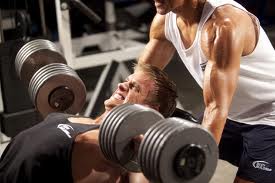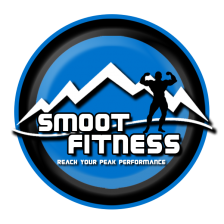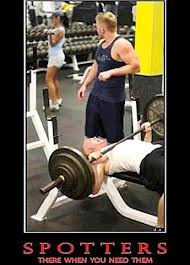
Sorry in advance for the rant, but it really amazes me that so many people in the gym do NOT know how to spot another lifter correctly. The other day I went for a new bench press PR (personal record) and asked the guy in the power rack next to me for a spot. I was going for three reps, the second rep was a grind, and I went for a third (against my better judgment) after being encouraged by my spotter to “Go for One More!”
So I went for that third rep. I lowered the bar down, tried to explode up, and got stuck about half way through the concentric phase (upward portion) of the lift. Now not only did this guy just stand there while he watched the bar go absolutely nowhere, but he waited about ten seconds before finally deciding to put two FINGERS on the bar in an attempt to help me grind out the remainder of the rep.
I could have shot him. I almost got stapled under the bar, and my chest and CNS (central nervous system) were so fatigued after that set, the numbers on all of my other lifts for the day suffered. If you get anything out of this article, be very careful with whom you let spot you.
When to Spot?
Ok so when exactly do you need a spotter? Generally speaking, any major compound lift such as the squat, bench press, overhead press, a heavy dumbbell press etc. is a good candidate for a spotter. Power exercises should not be spotted as the lifts are too explosive and athletes are taught to just let the weight go, isolation exercises should not be spotted unless you are a ten year old child who shouldn’t be in the gym anyway, and there really isn’t a way to spot the deadlift without making the athlete performing the lift feel extremely uncomfortable.
However, you should spend the majority of your time lifting without a spotter, regardless of the exercise. Max effort attempts or lifting to failure are really the only two scenarios where you would need a spotter, and both only make up about 10 percent of the overall training plan. The remainder of the time, you should be choosing weights and a proper progression that allows you perform the lifts on your own.
How Many Spotters?
Unless you are an elite level power lifter, you really don’t need more than two spotters, and most of the time you only need one. If having a group of people around you makes you feel safe and boosts your confidence, then by all means go with more than one spotter even if the load doesn’t warrant it. At the end of the day, you have to go with what you are most comfortable with.
Communication
Communication is a major responsibility of both the athlete and the spotter. Lift off or no lift off? Where should you spot? How many reps is the lifter going for? How close can you stand behind a female while she squats without her turning around and kicking you in the nuts? All of these questions need to be covered before an athlete ever starts to perform a lift. Fail to communicate and not only could it lead to serious injury, but you might end up in one of those “worst spotter in the world” memes. Whether you are the lifter or the spotter, your reputation in the gym will be trashed from that day on.
How to Spot
Alright I am going to make this short and sweet. A spotter is there for safety, to boost confidence, and to make sure the athlete lifts with proper technique; NOT to lift the weight for them. With that being said, a spotter is also not supposed to let you get stapled under the bar when you are going for a new bench record. This is my basic spotting technique:
- Communicate with the athlete and figure out how they want you to spot them.
- Watch the reps and cue the lifter if their form breaks down.
- If you see the athlete start to struggle, place your hands on the bar and put the minimal amount of force necessary to keep the weight MOVING. Don’t let the bar stop.
- Once they reach lockout, help the lifter rack the bar in the proper position.
Some athletes will want a lift off; some won’t. Some athletes will want your hands on the bar at all times; others will feel too crowded and it will ruin their set. You may have to take a good portion of the weight if an athlete misses a lift; you might not have to touch the bar at all. It all comes down to feel and adapting to the situation at hand. At the end of the day, the basic format remains the same no matter who you end up spotting.
Summing Up
I apologize for the rant, but people need to know how to spot correctly. There is always a risk of injury when an athlete attempts a weight they have never lifted before, and a spotter is meant to decrease that risk of injury, not magnify it. If you are in need of a spotter, choose carefully. If you are the one spotting, place all of your focus on the person performing the exercise, make them do most of the work, and ensure that they complete the lift safely and with proper technique. Ideally you shouldn’t have to assist the athlete at all, but if you do, that is the proper way to spot.
Nick Smoot
Email- nsmoot2@gmail.com
Twitter- Smootyn
Facebook- Smoot Fitness
Like What You See?
Get the Smoot Fitness Guide to Getting Stronger - FREE.



Leave a Reply